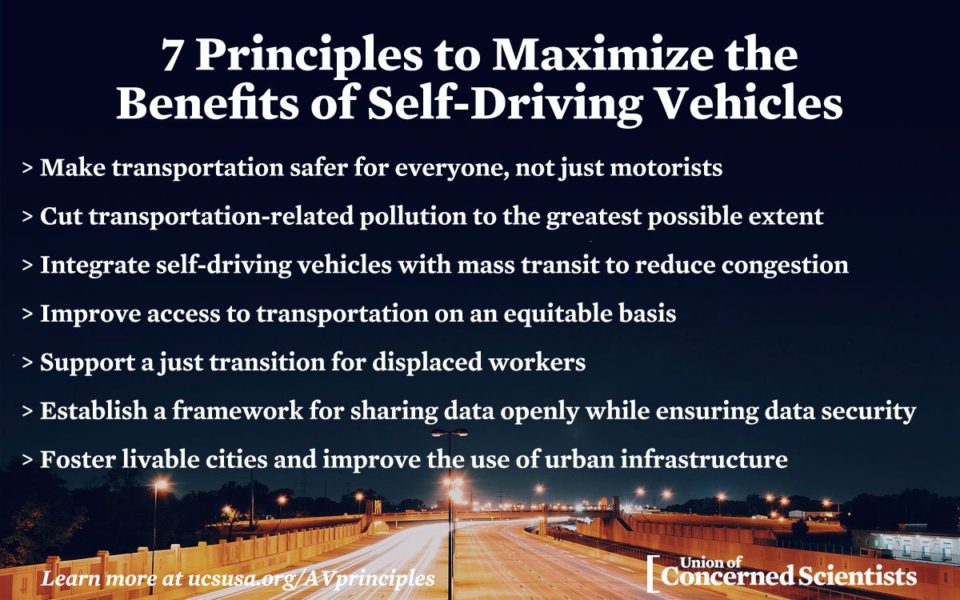Zipcar’s former CEO has cast the self-driving future as a “heaven or hell” scenario, and she has a point. Self-driving cars could save lives, smooth traffic congestion, expand access to jobs or schools—especially for people who can’t drive themselves today—and reduce the number of vehicles on our roads. On the other hand, they could worsen smog and local air quality pollution, disrupt the US economy by putting millions of people out of work, justify cuts in public transit funding and services, and force urban planners to focus more on providing space for vehicles instead of for parks, bicyclists, or pedestrians.
To maximize the potential benefits of self-driving vehicles and minimize their potential consequences, UCS developed this set of principles that we will be pushing policymakers, businesses, and other stakeholders to follow. Doing so will ensure that self-driving vehicles reduce oil consumption and global warming emissions, protect public health, and enhance mobility for everyone.
Science-based policy will be key for shaping the introduction of self-driving technology
Many are rallying against any regulation of self-driving technology beyond ensuring it’s safe to use. I’ve even heard the claim that over regulating this technology will literally kill people by slowing the speed at which self-driving cars are introduced, thus delaying their potential safety benefits.
To be fair, this argument has merit. Self-driving vehicles are forecast to reduce the tens of thousands roadway fatalities that occur each year in the US by as much as 90 percent, and can offset the rise of distracted driving that may have caused the biggest spike in traffic deaths in 50 years (though reaching these improved safety levels will take further advances in the technology and widespread deployment).
But, self-driving technology won’t just impact transportation safety. Researchers are forecasting how it will affect traffic congestion, vehicle-related emissions, land-use decisions, public transit systems, data security, and the economy. Unfortunately, the emphasis that many, including the US Department of Transportation, have placed on the safety benefits can be distracting from the need to consider how policy should address the other equally great potential impacts of self-driving technology.
I’m not saying self-driving technology should be regulated to the scrapheap. The technology is highly likely to improve traffic safety and increase access to transportation—both important outcomes. Yet self-driving vehicles will need to be regulated on issues other than safety, as their full breadth of potential impacts won’t be addressed by safety-focused policy or market forces alone.
For example, studies have found that self-driving vehicles could double transportation emissions (already the largest source of climate change emissions in the US), place millions Americans out of work as automated driving replaces truckers and taxi drivers, and/or exacerbate urban sprawl.
The jackpot for winning the race to produce the best self-driving vehicle can still be won even if these negative affects are suffered, and today’s policy frameworks may be insufficient to effectively curtail these future impacts. Let’s not forget that automakers have historically been against regulation (see: seat belts, fuel economy, air bags) and are encouraging policymakers to clear the way for self-driving vehicles not only because they seek to improve transportation safety, but because they see a potential to make a profit.
So science-based policy covering the broader implications of self-driving cars, including how they affect emissions and our economy, will be needed to ensure the best possible self-driving future and these discussions need to happen today. To kickstart these conversations, UCS released these principles that will create a safe, healthy, and equitable autonomous future. Join the conversation on whether and how self-driving technology should be regulated by checking out our new self-driving vehicle web content and signing up for future action alerts here.

